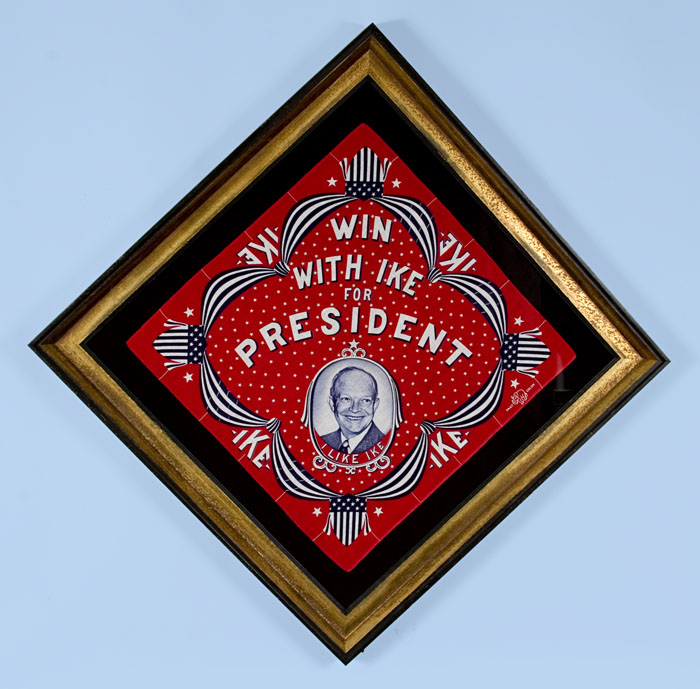
| |
PORTRAIT KERCHIEF FROM THE 1952 PRESIDENTIAL CAMPAIGN OF EISENHOWER & NIXON |
|
| Available: |
Sold |
| Frame Size (H x L): |
46" x 46" (52" x 52" on the diagonal) |
| Flag Size (H x L): |
36" x 36" |
|
| Description....: |
|
| PORTRAIT KERCHIEF FROM THE 1952 PRESIDENTIAL CAMPAIGN OF IKE EISENHOWER AND RICHARD NIXON:
Printed cotton kerchief, made for the 1952 presidential campaign of General Dwight David "Ike" Eisenhower and Richard M. Nixon. A portrait of Eisenhower appears above his famous slogan, "I Like Ike", within a flag-draped, oval frame, decorated with scrollwork and crowned with a star. Above this, in large lettering, is:
"Win With Ike For President"
The turkey red background has a white calico print in the center, surrounded by a swag border of red and blue stripes. "Ike" appears below the gathering of each valence and a patriotic shield anchors each corner. A maker's mark appears along the edge, and though it does not reveal the maker's name, the words "Fast Color" surround an image of an elephant, the Republican mascot.
A Brief History of Dwight D. "Ike" Eisenhower:
A U.S Army general, Eisenhower served as Supreme Commander of the Allied forces in Europe during WWII. He was immensely popular and produced landslide wins in both 1952 and 1956, losing only in the Democratic, deep South to his opponent, Adlai Ewing Stevenson II, Governor of Illinois. Stevenson's grandfather, Adlai Ewing Stevenson I, served as Vice President under Grover Cleveland following his second campaign win (1892), made an unsuccessful bid for the 1896 presidential nomination, then ran again for Vice President under William Jennings Bryan in 1900, who lost to McKinley and Roosevelt.
Born on October 14th, 1890, in Denison, Texas, Eisenhower grew up in Abilene, Kansas, where he "absorbed the virtues of small town America that distinguished him the rest of his life-scrupulous honesty, self-reliance, determination, and hard work as President" (U.S. Army Center of Military History, publication 71-40). Graduating from West Point in 1915, Eisenhower served as Captain during WWI but never left the States, which immensely disappointed him. During the signing of the Armistice, he was in command of Camp Colt, the Army's tank corps training center on the Civil War battlefield at Gettysburg. In 1930 he became special assistant to General Douglas MacArthur, then Chief of Staff, which vaulted him up the Army food chain.
Eisenhower followed McArthur to the Philippines, but after the bombing of Pearl harbor, he was summoned to Washington to serve under Franklin Roosevelt's U.S. Army Chief of Staff, General George C. Marshall, who would oversee the building of the largest military force in U.S. history. Marshall appointed Eisenhower chief of the War Plans Division (subsequently Operations Division), the office widely regarded as the brains of the Army. After the German surrender, Eisenhower, now Chief of Staff, presided over the postwar demobilization. During this time he became the Army's first Chief of Staff to participate in the newly created unified Joint Chiefs of Staff.
In 1948 Eisenhower retired from the Army to become president of Columbia University, but the Korean War followed shortly thereafter and in 1951 he became the first supreme commander of NATO. Eisenhower would eventually end the war as president and he maintained a stern eye on the Cold War during his tenure in the Whitehouse. He was the first president to be "constitutionally forced" from office, in 1961, having served the maximum two terms allowed by the 22nd Amendment to the U.S. Constitution (ratified in 1951, before he took office). He retired to Gettysburg, died in 1969 at Walter Reed Hospital, and was buried in his home town of Abilene Kansas. His funeral was presided over by then-president Richard Nixon, who had been Eisenhower's vice president for both terms.
Mounting: The kerchief has been hand-stitched to 100% cotton, black in color. The black fabric was washed to reduce excess dye. An acid-free agent was added to the wash to further set the dye and the fabric was heat-treated for the same purpose. The mount was then placed in a black-painted, hand-gilded and distressed Italian molding. Spacers keep the textile away from the glass, which is u.v. protective.
Condition: Excellent. |
|
|
|
| Collector Level: |
Beginners and Holiday Gift Giving |
|
| Flag Type: |
Parade flag |
|
| Star Count: |
|
|
| Earliest Date of Origin: |
1952 |
|
| Latest Date of Origin: |
1952 |
|
| State/Affiliation: |
|
|
| War Association: |
Korean |
|
| Price: |
Sold |
|
| |
Views: 3486 |
|
|
|

